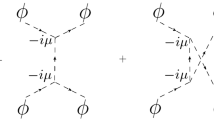Summary
In this paper we will present some calculations, based on the formalism constructed in a preceding paper, on the total amount of mass created by the gravitational field near the initial singularity when interacting with a quantum scalar field. The results of these calculations give infinite or very high mass amounts, so that this process is certainly able to account for the total mass of the observable universe.
Riassunto
Nel presente lavoro si presentano i risultati di alcuni calcoli, basati su un formalismo costruito in un precedente lavoro, relativi alla quantità totale di massa creata dal campo gravitazionale quando interagente, nei pressi della singolarità iniziale, con un campo scalare quantizzato. Si ottengono valori infiniti o molto grandi, tali da giustificare l’ipotesi che questo processo sia in grado di render conto di tutta la massa attualmente presente nell’universo osservabile.
Similar content being viewed by others
References
E. Pessa:Nuovo Cimento,37 B, 155 (1977).
R. B. Partridge andD. T. Wilkinson:Phys. Rev. Lett.,18, 557 (1967);E. K. Conklin andR. N. Bracewell:Phys. Rev. Lett.,18, 614 (1967);E. K. Conklin:Nature,222, 971 (1969);R. B. Partridge:Amer. Sci.,57, 37 (1969);S. P. Boughn, D. M. Fram andR. B. Partridge:Astrophys. Journ.,165, 439 (1971); see for a theoretical discussion of the background radiation anisotropyA. M. Anile:Astrophys. Space Sci.,29, 415 (1974);A. G. Doroshkevich, V. N. Lukash andI. D. Novikov:Sov. Astron.,18, 554 (1975).
C. W. Misner:Astrophys. Journ.,151, 431 (1968); see alsoR. A. Matzner andC. W. Misner:Astrophys. Journ.,171, 415 (1972);R. A. Matzner:Astrophys. Journ.,171, 433 (1972).
J. M. Stewart:Mont. Not. Roy. Astr. Soc.,145, 347 (1969);C. B. Collins andJ. M. Stewart:Mont. Not. Roy. Astr. Soc.,153, 419 (1971); see alsoC. B. Collins andS. W. Hawking:Astrophys. Journ.,180, 317 (1973).
Ya. B. Zel’dovich andA. A. Starobinskij:Sov. Phys. JETP,34, 1159 (1972);V. N. Lukash andA. A. Starobinskij:Sov. Phys. JETP,39, 742 (1974);V. N. Lukash, I. D. Novikov andA. A. Starobinskij:Sov. Phys. JETP,42, 757 (1976);E. Pessa:Lett. Nuovo Cimento,15, 291, 295 (1976); see also ref. (1).
See alsoE. Pessa:Temperature degeneracy and early Universe (paper submitted for publication).
H. S. Snyder:Phys. Rev.,71, 38 (1947).
C. N. Yang:Phys. Rev.,72, 874 (1947).
H. T. Flint:Phys. Rev.,74, 209 (1948).
E. A. B. Cole:Nuovo Cimento,66 A, 645 (1970).
R. Hagedorn:Suppl. Nuovo Cimento,3, 147 (1965);Nuovo Cimento,56 A, 1027 (1968).
See,e.g.,S. Frautschi,J. N. Bahcall,G. S. Steigman andJ. C. Wheeler:Comm. Astrophys. Space. Phys.,4, 121 (1971).
F. Bloch andA. Nordsieck:Phys. Rev.,52, 54 (1937).
Ya. B. Zel’dovich:JETP Lett.,12, 307 (1970).
V. N. Lukash andA. A. Starobinskij:Sov. Phys. JETP,39, 742 (1974).
We should discuss here Eddington’s and Dirac-Jordan’s ideas; see for a complete discussion of the concept of «mass of the Universe» and of related topicsJ. D. North:The Measure of the Universe (Oxford, 1965), p. 82–85, 123–125, 200–202.
See,e.g.,H. Urbantke:Creation of particles by gravitational fields, inProceedings of the International School of Physics «E. Fermi», Course XLVII,General Relativity and Cosmology, edited byR. K. Sachs (New York, N. Y., 1971), p. 383; an interesting classical analogue of these concepts is to be found, in cosmology, when introducing the concept of «zero point stress»; seeW. H. McCrea:Proc. Roy. Soc.,206 A, 569 (1951);G. C. McVittie:Proc. Roy. Soc.,211 A, 295 (1952);Astron. Journ.,58, 129 (1953).
G. Gamow:Rev. Mod. Phys.,21, 367 (1949).
See,e.g.,D. W. Sciama:Astrophysical cosmology, inProceedings of the International School of Physics «E. Fermi», Course XLVII,General Relativity and Cosmology, edited byR. K. Sachs (New York, N. Y., 1971), p. 183–236, chiefly p. 202.
Models of this type were considered in Newtonian and Charlier’s cosmological models: see ref. (16), We should discuss here Eddington’s and Dirac-Jordan’s ideas; see for a complete discussion of the concept of «mass of the Universe» and of related topicsJ. D. North:The Measure of the Universe (Oxford, 1965), p. 15–23.
See every recent textbook on Cosmology;e.g.,C. W. Misner, K. S. Thorne andJ. A. Wheeler:Gravitation, Chap. 29 (San Francisco, Cal., 1973).
See,e.g.,A. Sandage:Phys. Today,23, No. 2, 34 (1970).
Author information
Authors and Affiliations
Additional information
To speed up publication, the author of this paper has agreed to not receive the proofs for correction.
Rights and permissions
About this article
Cite this article
Pessa, E. Scalar-particle production near the singularity in an anisotropic universe. Nuov Cim B 41, 99–110 (1977). https://doi.org/10.1007/BF02726547
Received:
Published:
Issue Date:
DOI: https://doi.org/10.1007/BF02726547




